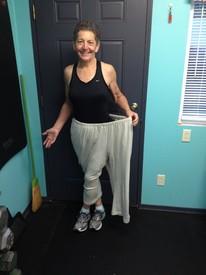There are multiple types of squats?
Options
Replies
-
Info in bold is not quite right. In a goblet squat, you hold the KB or Db at chest height with elbows out. In a "regular" weighted squat, your arms are straight and the weight hangs between your knees. Goblet squats are harder with the same poundage.peaceout_aly wrote: »The basic squat with a barbell and feet about shoulder width apart is a "squat" or some call it a standard or barbell squat.
Goblet squats are basically the same but instead of having a barbell on your shoulders you are holding a dumbbell.
In addition, there are sumo squats (wide stance with toes pointed outward), wide stance, box squats (you literally sit on a box and then stand with the barbell on your shoulders), pliet squats (heels together, toes pointed apart), single leg squats, split or Bulgarian squats (one leg up on a bench or box), front squats (done on the Smith machine...feet placed in front of you, used to target glutes and hamstrings) - the list goes on and on.
My best advice to target glutes prior to any squat is to do a warm up with bands - try doing kick backs, abductions, bridges, clamshells, etc. to get the glute muscles engaged. Personally, I find it difficult to really engage the glutes in a standard squat. In order to activate the glutes and lower back I would suggest deadlifts, especially stiff leg dead lifts. Another good one is hip thrusts!
You also can use a lighter weight and hold one in each hand, with arms hanging to your sides.
2 -
Info in bold is not quite right. In a goblet squat, you hold the KB or Db at chest height with elbows out. In a "regular" weighted squat, your arms are straight and the weight hangs between your knees. Goblet squats are harder with the same poundage.peaceout_aly wrote: »The basic squat with a barbell and feet about shoulder width apart is a "squat" or some call it a standard or barbell squat.
Goblet squats are basically the same but instead of having a barbell on your shoulders you are holding a dumbbell.
In addition, there are sumo squats (wide stance with toes pointed outward), wide stance, box squats (you literally sit on a box and then stand with the barbell on your shoulders), pliet squats (heels together, toes pointed apart), single leg squats, split or Bulgarian squats (one leg up on a bench or box), front squats (done on the Smith machine...feet placed in front of you, used to target glutes and hamstrings) - the list goes on and on.
My best advice to target glutes prior to any squat is to do a warm up with bands - try doing kick backs, abductions, bridges, clamshells, etc. to get the glute muscles engaged. Personally, I find it difficult to really engage the glutes in a standard squat. In order to activate the glutes and lower back I would suggest deadlifts, especially stiff leg dead lifts. Another good one is hip thrusts!
You also can use a lighter weight and hold one in each hand, with arms hanging to your sides.
I thought I could hold the kettlebell between my legs for a squat but I couldn't find a video on that! It's a little hard for me to hold it up still. I think I need to start with regular weighted ones until I get a bit stronger. Any chance you know of a video for form? I tried YouTube but kept getting goblet squat ones. That's how I ended up with this thread actually.0 -
You just hold the kettlebell straight down and squat. There are also kettlebell swings with a squat, but it sounds like yours is too heavy for that yet. Here's a good picture (ignore the "bench" part) http://www.fitnessrxwomen.com/training/workout-tips-advice/perfect-legs-glutes/bench-kettlebell-squat/1
-
DancingMoosie wrote: »You just hold the kettlebell straight down and squat. There are also kettlebell swings with a squat, but it sounds like yours is too heavy for that yet. Here's a good picture (ignore the "bench" part) http://www.fitnessrxwomen.com/training/workout-tips-advice/perfect-legs-glutes/bench-kettlebell-squat/
Thanks! Is my memory right that its to make sure your form is ok dont put your knees past your toes? and your back shouldnt be like a hill (should not curve down), but if it curves should curve upward instead and only slightly (thats what I see in the pic so I assume that part is right)?0 -
Verity1111 wrote: »DancingMoosie wrote: »You just hold the kettlebell straight down and squat. There are also kettlebell swings with a squat, but it sounds like yours is too heavy for that yet. Here's a good picture (ignore the "bench" part) http://www.fitnessrxwomen.com/training/workout-tips-advice/perfect-legs-glutes/bench-kettlebell-squat/
Thanks! Is my memory right that its to make sure your form is ok dont put your knees past your toes?
Not strictly true, it's more a case of your knees follow your toes, everybody squats a little differently and depending on the stance my knees could go beyond my toes (narrow/hip width) Play with foot position and stance to find what's best for you.
2 -
Even the standard barbell back squats have variations, each which are supposed to help with your overall strength and stability in the barbell back squat. Pause squats are where you take several seconds to pause in the bottom of the squat before ascending, and tempo squats are a variation where you purposefully lower yourself into the bottom of the squat as slowly as possible. With the barbell back squat there are 2 different ways to position the bar too. High bar is most commonly seen in Olympic lifting; it is where the bar is placed on top of one's shoulders, and when done properly, the person should appear upright the entire time and is activating their quadriceps muscles (front of the leg). Then there is the low bar version, which is more common in powerlifting as people tend to be able to move more weight with it. With this squat, the bar is lower on the back, sitting atop the spines of the scapula. With the low bar squat, you see a lot more forward lean vs upright positoning, and it calls for greater use of the hamstring muscles (back of the legs) than high bar). I could literally go on all day but I'll just stop myself here. Hope this helps a bit!1
-
maranarasauce93 wrote: »Even the standard barbell back squats have variations, each which are supposed to help with your overall strength and stability in the barbell back squat. Pause squats are where you take several seconds to pause in the bottom of the squat before ascending, and tempo squats are a variation where you purposefully lower yourself into the bottom of the squat as slowly as possible. With the barbell back squat there are 2 different ways to position the bar too. High bar is most commonly seen in Olympic lifting; it is where the bar is placed on top of one's shoulders, and when done properly, the person should appear upright the entire time and is activating their quadriceps muscles (front of the leg). Then there is the low bar version, which is more common in powerlifting as people tend to be able to move more weight with it. With this squat, the bar is lower on the back, sitting atop the spines of the scapula. With the low bar squat, you see a lot more forward lean vs upright positoning, and it calls for greater use of the hamstring muscles (back of the legs) than high bar). I could literally go on all day but I'll just stop myself here. Hope this helps a bit!
Lord. lol. and Im done for the day haha that's so much information thank you! Ill reread it a few times to try to remember it all xo I appreciate it.0 -
Just checked my book on Strength Training: Exercises for Women (author: Joan Pagano).
To be fair, these are for all levels from "I've never done a squat in my life without falling over" to "If squatting were an Olympic Event, I'd be on the national team". Though she doesn't include barbell exercises. (The first two aren't really squats, more like preliminaries to get you comfortable with the idea.)
So. In order:- Chair stand
- Resistive chair stand
- Chair squat
- Ball squat
- Squat with weights
- Side squat with knee lift using stability ball
- Side squat with weights (and cardio step)
- Balance clock (one-legged mini-squats on a cardio step)
- One-legged squat (using a chair)
- Mini-squat with press
1
This discussion has been closed.
Categories
- All Categories
- 1.4M Health, Wellness and Goals
- 396.8K Introduce Yourself
- 44.2K Getting Started
- 260.9K Health and Weight Loss
- 176.3K Food and Nutrition
- 47.6K Recipes
- 232.8K Fitness and Exercise
- 451 Sleep, Mindfulness and Overall Wellness
- 6.5K Goal: Maintaining Weight
- 8.7K Goal: Gaining Weight and Body Building
- 153.3K Motivation and Support
- 8.3K Challenges
- 1.3K Debate Club
- 96.5K Chit-Chat
- 2.6K Fun and Games
- 4.5K MyFitnessPal Information
- 16 News and Announcements
- 18 MyFitnessPal Academy
- 1.4K Feature Suggestions and Ideas
- 3.1K MyFitnessPal Tech Support Questions





